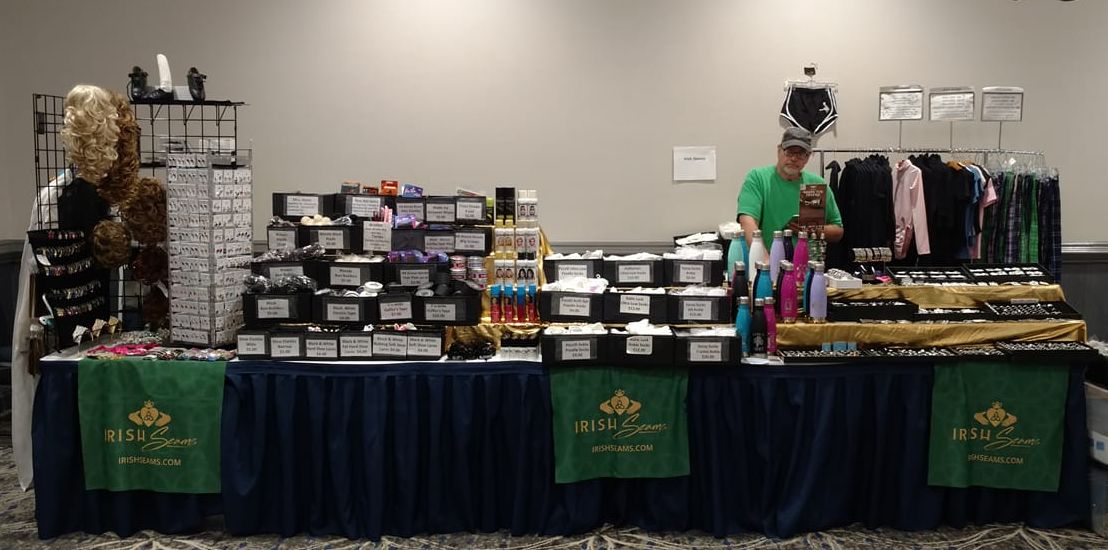So, your child started Irish dancing a little while ago and their teacher is saying that it’s time for their first… “fesh.” But what the heck is a “fesh?” Don’t worry, a lot of people ask that question the first time they hear about them. Feis (pronounced fesh) or Feiseanna (pronounced fesh ah na) for more than one, is what Irish dance competitions are usually called. At Feis, dancers are usually split up into different competition groups along the lines of age, skill level, gender, and dance (like jigs and reels). There are usually multiple stages so that multiple competitions can be going on at once.
Your first competition in any sport can be a bit chaotic and confusing, and Irish dance is no exception to that. If anything, it can be a lot more confusing than most team sports would be. This article will help you get through your first Feis in one piece. So here’s what you need to know:
#1: Key Details To Ask Your Teacher For
For your first Feis, your teacher will usually sign your dancer up for you. You need to find out from them what age group your dancer is in, what dance they’re doing, when they are dancing, and where the venue is. This is also a good time to ask what your dancer should be wearing for their dance and what they should do about their hair because every school has its own rules for costumes and hair. Some even have preferences for what type of socks your dancer should be wearing and how high they should be. (For more information on the different types of socks, check out our article here.) This is also a good time to ask about how you should get your dancer’s shoes tied if you need assistance with how Irish dance shoes are done up.
Some schools will have a special costume they want their dancers to wear at Feis, especially early on. Others will just want a black skirt and either a white shirt or a black long-sleeve leotard, which is called a ‘blackout’ costume. You should also bring a low-key hair tie to keep their hair neat and out of their face, but if it’s your first Feis you don’t need to worry about getting a wig.
Another very important thing to check ahead of time is whether the Feis you’re signed up for wants you to print and bring your dancer’s number card or if you need to get one when you arrive. Your dancer’s number card is a piece of paper that has both an identifying number for your dancer and a list of important information like what competition sets they are signed up for. Whether you can get this early or not, it’s good to look up the Feis’ syllabus and schedule on their site so you can figure out what stage and time slot your dancer will have. If you can get their number card early this is easy, because their set numbers are printed on the back.
If you cannot get your number card early, you can still figure out what sets your dancer will be in and when as long as you can get the syllabus. These set numbers tend to look something like 106RL or 213SN, but the exact format can vary based on the individual Feis. Most syllabi will include a good explanation of what their format is and how set numbers are assigned, so as long as you know the dancer’s skill level, age, and what dance they are signed up to do you can use the syllabus to get their set numbers. We advise printing out the schedule and highlighting your dancer’s sets ahead of time so you don’t have to figure it out on the day of, this can be a godsend on Feis day.
#2: What You Should Pack
First and foremost is of course your dancer’s gear, as we just covered. This includes their dance shoes, their dance socks, and their costume. Remember to check what shoes your dancer will need! You can’t wear hard shoes for a softshoe dance, or vice versa. If it’s your first Feis you will probably just need soft shoes, but if you’ve been dancing for a while your teacher might want your dancer in a hard shoe competition as well.
Once you’ve got that sorted, it’s time for the less obvious stuff. You’re going to want to bring water and snacks for everyone in your group, with extra water for any dancers. It’s worth checking on the Feis’ website to see if they allow outside food and drink before doing this, though. If they don’t, they almost always have concessions (usually chicken tenders and chips, occasionally things like wraps) at the event and usually no one is going to make a fuss about a couple of granola bars and a bottle of water in a dance bag- just don’t bring the picnic basket or a cooler.
If you’ve got kids who aren’t dancing in your group, you should make sure to bring something for them to do while they wait. Books are an old classic for this, but if they prefer videos or games on something they can bring with them that’s also fine. We recommend headphones or some other sort of hearing protection for everyone in your group though because Feis can be loud. Even with those, it’s not a good environment to be doing homework in.
It’s also a good idea to bring a sort of picnic blanket for you and your kids to be a bit off the floor. Camping chairs are even better, but there won’t always be space to set them up in the location. The best ways to find out whether you will be able to use them ahead of time are to ask another parent who has been to that Feis before and to read the syllabus. If it says “no camping” they probably won’t allow chairs and blankets, but if you’ve got space it can be worth them in the trunk anyway just in case. If the weather is good you may find a nice spot outside to sit between dances.
#3: Have A Plan To Get To The Feis
New dancers tend to be the first groups that dance, so you should try to be getting into the Feis as soon as the venue’s doors open. If you’ve confirmed with your teacher that your dancer is going later in the day, you should still make sure to give yourself an hour or so of lead time to be safe. It sounds like a lot, we know, but you’d be amazed at how quickly time can slip away trying to get to a Feis in time.
Make sure you’ve double-checked your route there and left a bit of extra time for Feis traffic- after all, there’s going to be a lot of other families trying to reach that building at the same time! This part can be very frustrating because of the extra traffic and trying to find your way to a place that might be a bit obscure, but it’s important to keep calm and focus on keeping your dancer’s morale up if things go wrong, especially if they’re younger.
If the location is a reasonable distance from your home, it can be worth it to drive there ahead of time just to see where it is with no time pressure. If it’s not, and a lot of Feis won’t be, google street view can be super useful for getting familiar with some of the landmarks around the location. Most of the time your teacher will try to make sure your first Feis is close enough that you won’t need a hotel, but if you do need one make sure to book very early- just like with traffic, there will be a lot of people trying to get rooms in that area for that day. Often times Feis are held in hotels, and when they are the organizers usually organize a discounted ‘Feis rate’ for rooms at that hotel for people going to the Feis. These rooms always go super quickly, but if you can snag one they’re very convenient.
#4: You Can Ask For Help At The Feis
Once you’ve gotten into the Feis, there are going to be a lot of moving parts. If you didn’t print off your card or get it in the mail ahead of time, you will need to pick up your dancer’s number card, you will need to sign in with the Feis organizers, you will need to find a place to set up your little camp, and you will need to get your dancer geared up.
Because every Feis is so different, one of the best ways to handle everything going on will be to ask for help from another dance parent. Talk to someone in your school who has been to Feis before and ideally to the Feis you’re going to, and see if you can’t buddy up with them to see how it’s all done. It’s important to remember that everyone who has been to a Feis has been through the chaos you’re facing right now, and most of them will be willing to lend you a hand as long as you’re willing to learn and not just make them do it.
So don’t be afraid to ask people where registration is, or where the stages are, or where results will be posted, or where there are good spots to set up camp for the Feis, or especially where the bathrooms are.
#5: Remember To Be Patient
The most important thing you need to keep in mind throughout this process is that you need to stay calm. Feis can be chaotic at times, yes, but life has a way of spiraling even more out of control when we lose our cool. It’s almost always better to take a deep breath and think for a moment instead of freaking out.
This is also incredibly important for managing morale in the rest of your party. And you will need to. A dancer’s first competition can be stressful and scary, especially for younger kids. They’re going to be performing for the first time in front of a crowd of strangers and literally being judged for it. As you might expect from that, it can be a bit stressful for them.
So don’t worry when you’re a bit late getting out because someone lost a shoe or traffic is worse than you expected. Don’t worry when you’re in a crowded, maze-like building you’ve never been in before. Don’t worry when your dancer seems to be doing something completely different from what the other kids on stage are doing. You prepared extra time for this, there are people around who you can ask for help, and teachers often have kids doing very different steps on stage.
Your first Feis can feel like a massive ordeal, but no matter what happens it will not be the end of the world. And hey, once it’s all over you have a great excuse to go out for ice cream.
You can find more Feis-related news on our Facebook page, such as when registrations open and which Feis we’ll be attending as vendors!

Make sure to say hi if you see us!
